DesignCon is north America's largest chip, board, and systems event, and took place the last week in Jan for its 25th year. The event brings together the brightest minds across the high-speed communications and semiconductor industries who are looking to engineer the technology of tomorrow. Topics and areas of coverage included: Signal and power integrity, System co-design: model and simulation, Applying test and measurement methodology, IBIS-AMI model generation, validation, and simulation strategies, Materials & processing for PCBs, modules & packages, Electromagnetic compatibility (EMC) and interference (EMI), Artificial intelligence, Connectivity (5G), IoT, I/O interface design, FPGA/ASIC and Machine learning.
DesignCon 2020 kicked off for SI Journal with an “Ask the Experts” panel in the Chiphead Theater on Wednesday. Moderated by SIJ Technical Editor Eric Bogatin, the panel included SIJ Editorial Advisory Board members Istvan Novak, Steve Sandler, Vladimir Dmitriev-Zdorov, and Larry Smith, and featured a standing room only crowd (Figure 1 and 2). The Chiphead Theater also hosted another SIJ sponsored panel “Untangling Standards: The Challenges Inside the Box,” Moderated by Jay Diepenbrock, this panel included Ken Schmahl, Cristin Filip, Stephanie Rubalcava and tackled the standards for DDR5 and PCIe.
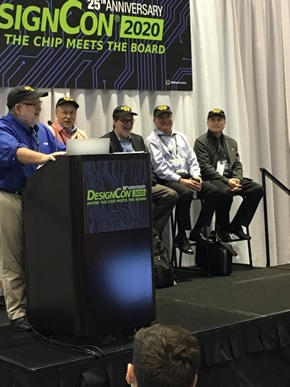
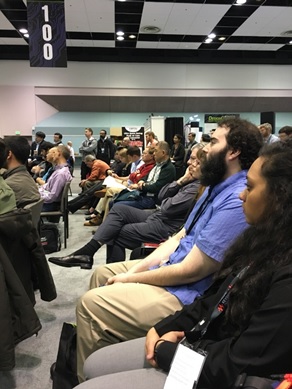
DesignCon announced Istvan Novak, Principal Signal and Power Integrity Engineer, Samtec, as the 2020 winner of the engineer of the year award. The engineer of the year award recognizes the best of the best in engineering and product advancements at the chip, board, or system level. Each year, the award winner receives a $1,000 grant or scholarship to present to the educational institution of their choice. Novak has selected to donate to the radio club of the Technical University of Budapest.
Check out the DesignCon 2020 photo gallery and video library.
In the exhibition, we saw the following products and innovations from some of the leading companies in the industry:
Altair recently announced the acquisition of Polliwog Co. Ltd., a high-tech software company based near Seoul, providing EDA software to the rapidly growing electronics industry. Polliwog expands Altair’s solution portfolio for system-level engineering to the PCB design and analysis market. Their products include a powerful PCB modeler, simulation solvers, and design verification tools, and integrates seamlessly into customer environments that use any of the leading ECAD PCB design solutions.
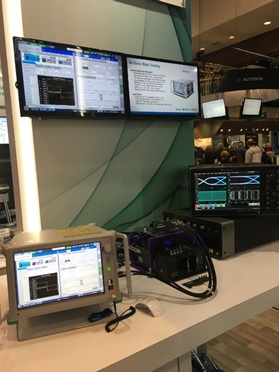 Anritsu Company introduced the VectorStar™ ME7838G broadband vector network analyzer which is the industry’s first VNA capable of making measurements from 70 kHz to 220 GHz in a single sweep. The new VectorStar VNA allows engineers to more accurately and efficiently characterize devices over a much broader range of frequencies to provide accurate device models, thus optimizing the chance for accurate simulations and opportunity to reduce design turns. Anritsu featured a new PCI Express test solution that supports the PCIe 5.0 Base/CEM Specification Stressed Receiver Test. At the center of the demonstration was the Signal Quality Analyzer-R MP1900A Series with installed Automation Software for base specification calibration and BER Measurement Software supporting the SKP Filter. With the system, engineers can easily configure a measurement environment for early-stage development of PCIe 5.0 IP and devices, expediting the rollout of technology. The MP1900A was featured in other demonstrations on verifying high-speed designs. It was integrated with the BERTWave™ MP2110A and MS9740B OSA to conduct 400G optical PAM4 TDECQ tests, as well as in a configuration to conduct automated high-speed serial bus RX tests.
Anritsu Company introduced the VectorStar™ ME7838G broadband vector network analyzer which is the industry’s first VNA capable of making measurements from 70 kHz to 220 GHz in a single sweep. The new VectorStar VNA allows engineers to more accurately and efficiently characterize devices over a much broader range of frequencies to provide accurate device models, thus optimizing the chance for accurate simulations and opportunity to reduce design turns. Anritsu featured a new PCI Express test solution that supports the PCIe 5.0 Base/CEM Specification Stressed Receiver Test. At the center of the demonstration was the Signal Quality Analyzer-R MP1900A Series with installed Automation Software for base specification calibration and BER Measurement Software supporting the SKP Filter. With the system, engineers can easily configure a measurement environment for early-stage development of PCIe 5.0 IP and devices, expediting the rollout of technology. The MP1900A was featured in other demonstrations on verifying high-speed designs. It was integrated with the BERTWave™ MP2110A and MS9740B OSA to conduct 400G optical PAM4 TDECQ tests, as well as in a configuration to conduct automated high-speed serial bus RX tests.
The ShockLine™ MS46524B 4-port VNA conducted de-embedding and network extraction measurements, and the VectorStar™ MS4640B was in a 110 GHz signal integrity measurement configuration for more efficient device modeling. Anritsu Company also introduced the ShockLine™ MS46131A USB vector network analyzer (VNA), the industry’s first modular 1-port VNA that supports measurement frequencies up to 43.5 GHz. With 8 GHz and 20 GHz models also available in the series, the MS46131A brings cost and efficiency advantages to measuring antennas and other 1-port 5G devices at sub-6 GHz, as well as in the 28 GHz and 39 GHz millimeter wave (mmWave) bands.
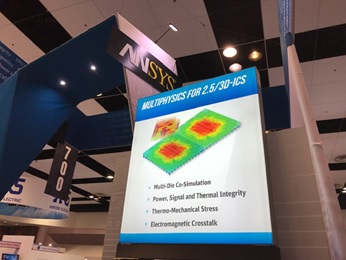 ANSYS discussed how high-speed electronics systems, such as 5G, ADAS, IoT and other wireless and digital systems, is driving high levels of integration, pushing the limits of battery life and continuing to reduce the size of electronic components. For engineers to design within resultant shrinking timing and noise margins in PCBs, electronic packages and complex interconnects, they require a multiphysics engineering environment for simulating and designing entire electronics products. ANSYS simulation technology for chip–package–board design empowers users to evaluate electrical, thermal, and structural behavior before build and test. It enables design teams to optimize systems performance and achieve first-pass design success.
ANSYS discussed how high-speed electronics systems, such as 5G, ADAS, IoT and other wireless and digital systems, is driving high levels of integration, pushing the limits of battery life and continuing to reduce the size of electronic components. For engineers to design within resultant shrinking timing and noise margins in PCBs, electronic packages and complex interconnects, they require a multiphysics engineering environment for simulating and designing entire electronics products. ANSYS simulation technology for chip–package–board design empowers users to evaluate electrical, thermal, and structural behavior before build and test. It enables design teams to optimize systems performance and achieve first-pass design success.
ANSYS 2020 R1 was recently announced and continues to integrate simulation throughout product life cycles, from ideation to virtual testing to operation, with ANSYS Minerva. This cutting-edge platform spurs collaboration within global engineering teams and increases data sharing to innovate product designs and slash development costs. The release also includes enhancements to ANSYS Mechanical to help engineers design complex, highly nonlinear and extremely large models. This release also features a greatly simplified workflow in ANSYS Fluent, so even novice engineers can execute complex multiphase simulations quickly and easily. Other portfolio upgrades include dynamic new tools for ANSYS HFSS SBR+ and ANSYS Maxwell that substantially improve processes for electronic/electromagnetic design.
Cadence was featuring the following demonstrations:
- PCB-/package-level signal and power integrity analysis
- True 3D electromagnetic (EM) field solver for PCB, IC package, and on-/off-chip parasitic extraction
- Electrical-thermal co-simulation for system analysis
- Cross-domain, multi-chip(let) package design flows
- Advanced GDDR6 solution for AI, ML, and network applications
- Solving complex photonic IC challenges using an integrated electronic/photonic design automation (EPDA) environment
Carlisle showcased its CoreHC Ganged Interconnect System, a multi-port system that spans DC – 65 GHz. For attendees at DesignCon, the focus was on small pitch, sub 4 mm products, such as 2.5, 1.5, and 1 mm. Carlisle’s Emad Soubh (Director of Engineering, CarlisleIT) noted that several attendees were also asking for multiple high-speed channels going to 50GHz at 0.3 mm and 0.4 mm pitch. He hinted that something like that might be in development.
Epson and Rohde & Schwarz announced their joint development of a modern test procedure for measuring power supply noise rejection to bring clarity and precision to real-world signal integrity design challenges. The companies introduced and demonstrated the procedure and summarized data from Epson’s SG3225EEN low noise differential crystal oscillator measured by the R&S FSWP phase noise analyzer from Rohde & Schwarz. Epson and Rohde & Schwarz’s paper proposes measurement techniques to quantify power supply noise's contribution to jitter using commonly available test and measurement equipment.
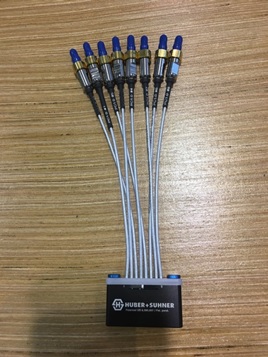 HUBER+SUHNER demonstrated its cutting-edge 70 GHz test lead SUCOFLEX 570S and the state-of-the-art MXPM90+ for multicoax measurements up to 90+ GHz. The high-performing, low-loss SUCOFLEX 570S test lead is suitable for a vast-range of applications including bench top testing, RF production, automated test equipment, Vector Network Analysers (VNAs), portable testing equipment and RF module testing up to 70 GHz. Developed in response to the most stringent testing requirements, they showed the electrical stability and reliability of the MXPM90+ multicoax solution which will create revolutionary high-speed testing and a frequency rate up to 90 GHz+. Designed for bench top testing, RF module testing and high-speed digital testing (HSDT), the best-in-class multicoax connector solution provides users with a higher level of precision with an advanced magnetic locking mechanism.
HUBER+SUHNER demonstrated its cutting-edge 70 GHz test lead SUCOFLEX 570S and the state-of-the-art MXPM90+ for multicoax measurements up to 90+ GHz. The high-performing, low-loss SUCOFLEX 570S test lead is suitable for a vast-range of applications including bench top testing, RF production, automated test equipment, Vector Network Analysers (VNAs), portable testing equipment and RF module testing up to 70 GHz. Developed in response to the most stringent testing requirements, they showed the electrical stability and reliability of the MXPM90+ multicoax solution which will create revolutionary high-speed testing and a frequency rate up to 90 GHz+. Designed for bench top testing, RF module testing and high-speed digital testing (HSDT), the best-in-class multicoax connector solution provides users with a higher level of precision with an advanced magnetic locking mechanism.
 Keysight demonstrated the widest variety of design and test solutions to address high-speed digital measurement challenges. The demos included a total solution approach to DDR5 transmitter test. They provide new measurement science for efficient and accurate measurement results that include automated compliance test for faster test time, BGA interposer for easy access to signal for testing, and seamless connection to data repository for quick test result analysis and fast decision-making process. Keysight demonstrated DDR5 receiver test using the M8020A BERT, UXR-Series oscilloscope, and M80885RCA DDR5 Rx compliance test software. ght is the only T&M company on the PCI-SIG board. Keysight also demonstrated a new PCI Express (PCIe) 5.0 transmitter test solution with the UXR-Series oscilloscope and D9050PCIC PCIe 5.0 Tx compliance test software. Keysight demonstrated a PCIe 5.0 receiver test solution with the M8040A BERT, UXR-Series oscilloscope, and N5991 Rx compliance test software to validate a robust receiver that can tolerate significantly attenuated signals at 32 GT/s.
Keysight demonstrated the widest variety of design and test solutions to address high-speed digital measurement challenges. The demos included a total solution approach to DDR5 transmitter test. They provide new measurement science for efficient and accurate measurement results that include automated compliance test for faster test time, BGA interposer for easy access to signal for testing, and seamless connection to data repository for quick test result analysis and fast decision-making process. Keysight demonstrated DDR5 receiver test using the M8020A BERT, UXR-Series oscilloscope, and M80885RCA DDR5 Rx compliance test software. ght is the only T&M company on the PCI-SIG board. Keysight also demonstrated a new PCI Express (PCIe) 5.0 transmitter test solution with the UXR-Series oscilloscope and D9050PCIC PCIe 5.0 Tx compliance test software. Keysight demonstrated a PCIe 5.0 receiver test solution with the M8040A BERT, UXR-Series oscilloscope, and N5991 Rx compliance test software to validate a robust receiver that can tolerate significantly attenuated signals at 32 GT/s.
Other demos included a total solution approach to 400GE transmitter characterization. 400G signaling technology presents extremely tight design margins, and engineers demand higher instrumentation precision to extract margin for Tx characterization and validation. The demo station examined SNDR and related 400G validation measurements on Keysight’s N1000A DCA-X sampling and UXR-Series oscilloscopes. Keysight also demoed a solution to design next-generation digital interfaces running at speeds beyond 60 GBaud. It offers great flexibility in terms of speed, modulation formats, as well as digital signal processing at the transmitter and receiver side. This solution includes Keysight’s M8196A AWG and UXR-Series oscilloscope. Another demo included a compliance test solution for 400GBASE devices and components. The solution consisted of the M8040A BERT, combined with the A400GE-QDD, and a multiport 400G Ethernet module tester. It is designed to integrate FEC constraints into the physical design validation. Keysight also demoed its A400GE-QDD 400G Layer 1 BERT and FEC measurement system that provides BERs simultaneously on all electrical lanes in real-time. The A400GE-QDD evaluates the performance of FEC for PAM4 encoded signaling in a fast (minutes not days) and efficient manner. Another demo demo showcased Keysight’s solutions for USB4 over a lossy, low-cost, passive cable using the UXR-Series oscilloscope.
For signal integrity analysis, Keysight demoed how a digital designer can develop intuitive insight into the transmission of digital data from the transmitter through the channel interconnects to the receiver. For power integrity, Keysight demoed software and hardware for designing, measuring, and analyzing power distribution networks. PathWave ADS PIPro Software provides power integrity analysis of power distribution networks (PDN), including DC IR drop analysis, AC impedance analysis, and DeCap optimization. Model building and PI channel measurement will be shown with the P5028A Keysight Streamline USB Vector Network Analyzer. They also showed the N7020A Power Rail Probe and the D9010POWA Power Integrity Analysis Software, which together complement each other and provide a powerful means of measuring and analyzing power integrity.
Keysight demoed system simulation of DDR5 using IBIS-AMI models, with an enhanced bit-by-bit channel simulator adapted specifically to the needs of DDR. PathWave ADS 2020 U1, provides a fast system setup with Memory Designer, an easy and accurate EM extraction process with SIPro, and the capability to close the loop with measurement on hardware by performing the same compliance tests on simulated waveforms. PathWave Desktop Edition is a design and test software platform for agile and connected engineering workflows. It accelerates your product development workflow by connecting every step in your path — from design and simulation, to prototype and test, to manufacturing — connected and integrated.
I-PEX Connector released NOVSTACK 35-HDN connector for 5G mmWave modules that is fully shielded with narrow design, 0.35 mm pitch, 0.7 mm height. It is ideal for high frequency applications (5G mmWave, Thunderbolt™3, etc.) and fully shielded design decreases EMI caused by 5G applications. It has a narrow depth and low height, and fully shielded board-to-board connector. The features include:
- Contact Pitch (mm): 0.350
- Mated Height (mm): 0.75 Max. (0.70 mm Nominal)
- Available Pin Count: 10 30
- Frequency Range: Up to 15 GHz
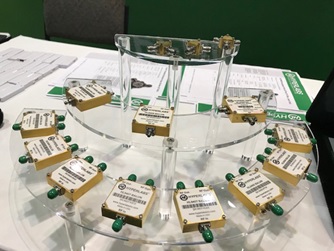 Hyperlabs recently released the HL9477, a 6 dB power divider that provides outstanding amplitude and phase symmetrical power division from DC to beyond 67 GHz. This ROHS-compliant product is designed using a three-resistor network resulting in outputs that are nominally attenuated to 6 dB, and all ports are impedance matched to 50 Ohms when the ports are terminated. The HL9477 is designed suitable for use in multi-Gbps communications systems, highspeed analog-to-digital conversion, frequency response testing for differential devices, and many other applications. In the same product family, the HL9475 offers 50 GHz bandwidth, the HL9474 offers 40 GHz bandwidth and the HL9472 offers 20 GHz bandwidth.
Hyperlabs recently released the HL9477, a 6 dB power divider that provides outstanding amplitude and phase symmetrical power division from DC to beyond 67 GHz. This ROHS-compliant product is designed using a three-resistor network resulting in outputs that are nominally attenuated to 6 dB, and all ports are impedance matched to 50 Ohms when the ports are terminated. The HL9477 is designed suitable for use in multi-Gbps communications systems, highspeed analog-to-digital conversion, frequency response testing for differential devices, and many other applications. In the same product family, the HL9475 offers 50 GHz bandwidth, the HL9474 offers 40 GHz bandwidth and the HL9472 offers 20 GHz bandwidth.
IW-Microwave Products Division’s extremely Low Loss Cable Assemblies are optimized for operation in their respective frequency bands from low MHz to 67 GHz. Upon request they can accommodate custom assembly configurations and can extrude a broad range of jacketing materials. Our jacketing capabilities allow us to produce assemblies that have extra flexibility, extended flex life, low and high temperature ranges, and resistance to oils and corrosive materials. Our standard assemblies are extruded with FEP.
Junkosha was featuring their MWX161 slim phase stable cables that operates up to 67 GHz. Features include cable assemblies with a small diameter at the neck, making it the most suitable for a Multiport VNA; a torque driver is available to mount on narrow pitch connector arrangement board; cable assemblies with excellent phase stability against bending and temperature; cable assemblies with excellent mechanical characteristics using SUS flexible tubing for protection; and a wide range of connectors: 3.5 mm, 2.92 mm, 2.4 mm and 1.85 mm.
Langer EMV-Technik was featuring their near-field probes are used for accompanying measurements of high-frequency, electric and magnetic RF fields on assemblies and devices. They offer these models:
- LF, Passive, 100 kHz - 50 MHz
- RF, Passive, 30 MHz - 3 GHz
- XF, Passive, 30 MHz - 6 GHz
- SX, Passive, 1GHz - 20 GHz
- MFA, Active, 1MHz - 6 GHz
- CM-SHP, Customized Shapes: Langer EMV-Technik GmbH also manufactures special shapes of near-field probes according to customer requirements.
Langer also offer probes for ICs that allow for injection of fast, transient magnetic field, E-field and current pulses into ICs. The offer these models:
- ICI HH500-15 L-EFT, Pulse Magnetic Field Source: The ICI HH500-15 L-EFT pulse magnetic field source couples fast transient pulses into a test IC (open die). This allows for side channel analysis or testing the immunity of individual areas of the IC.
- ICI E450 L-EFT, Pulse E-Field Source: The ICI E450 L-EFT pulse electric field source couples fast transient pulses into a test IC (open die). This allows for side channel analysis or testing the immunity of individual areas of the IC.
- ICI I900 L-EFT, Pulse Current Source (FBBI): The ICI I900 L-EFT pulse current source couples fast transient pulses into a test IC (Forward body biased injection). This source allows for side channel analysis or testing the immunity of individual areas of the IC.
They also offer sets that include various combinations of these probes and cables.
In its booth, Introspect Technology had a live setup of its DDR5 test system as well as PCI Express Gen4 and Gen5 products. The DDR5 test solution is an ATE-on-a-Bench setup used to characterize memory modules. The PCI Express Gen4 and Gen5 demonstrations highlighted link equalization measurement, loopback training, and receiver testing across multiple lanes.
MathWorks and SiSoft highlighted how high-speed DDR5 and PAM4 interfaces can be designed using MATLAB and Quantum-SI/ Quantum Channel Designer for channel simulation  and IBIS-AMI modeling. Last year, the merger between the two companies was announced just before DesignCon. This year, the team was highlighting the full workflow between the SiSoft SerDes Toolbox interface and Mathworks products, which includes a model library and a set of analysis tools and apps for the design and verification of serializer/deserializer (SerDes) systems.
and IBIS-AMI modeling. Last year, the merger between the two companies was announced just before DesignCon. This year, the team was highlighting the full workflow between the SiSoft SerDes Toolbox interface and Mathworks products, which includes a model library and a set of analysis tools and apps for the design and verification of serializer/deserializer (SerDes) systems.
Mentor Graphics was demonstrating its HyperLynx family of high-speed design tools including electrical design rule checking, signal integrity, power integrity and integrated 3D electromagnetic modeling. Techniques included analysis flows for DDRx, compliance-based SerDes channels and power delivery network (PDN) design, 112G SerDes channel compliance analysis, DDR5 design with IBIS-AMI models, automating PDN decoupling capacitor selection, and board-level modeling of high-speed signals with complete return paths
Molex and Spectra7 Microsystems showed 400 Gbps Active Copper Cables (ACCs) at the event. Significant US Hyperscaler deployment of 400 Gbps network equipment will begin in 2020 and according to a recently published report by Dell’Oro Group1, total 400 Gbps shipments are forecast to surpass 15 M switch ports by 2023. GaugeChanger™ is an innovative and disruptive technology that allows copper to extend much longer lengths without the cost and power penalty of optics. It works equally well at 25 Gbps NRZ and 50 Gbps PAM-4 enabling new connector standards of 100, 200 and 400 Gbps.
Molex recently began shipping its Passive Copper QSFP-DD (Quad Small Form Factor–Double Density) Cable Assemblies in volume production and the same customers are asking for Active Copper versions for longer lengths. The Molex system along with Spectra7’s GaugeChanger™ technology offers up to 12 times less power, while providing significant cost savings over optical solutions for hyperscale customers.
Rogers Corporation highlighted High Speed Digital Laminates & Next Generation Thin Materials for Millimeter Wave Multilayer Designs. Their high-performance circuit materials used in multilayer structures include a family of thin laminates, bonding materials, and sheeted copper foil options. Rogers’ XtremeSpeed RO1200 high speed, extremely low loss laminates, with a low dielectric constant of 3.05, and a maximum dissipation factor of 0.0017 @10 GHz, provide outstanding signal integrity, reduced signal skew, and reduced crosstalk. Combined with superior thermal/mechanical performance, low CTE, and a halogen free UL 94 V-0 rating, these laminates are well suited for the most demanding high layer count applications.
RO4835T™ laminates, offered in a 2.5 mil, 3 mil and 4 mil core thickness, are 3.3 Dk, low loss, spread glass reinforced, ceramic filled thermoset materials are designed for inner-layer use in multilayer board designs, and they complement RO4835™ laminates when thinner cores are needed. RO4450T™ 3.2-3.3 Dk, low loss, spread glass reinforced, ceramic filled bonding materials were designed to complement RO4835T laminates and the existing RO4000 laminate family, and come in 2.5, 3, 3.5, 4, 4.5, 5 or 6 mil thicknesses. RO4835T laminates and RO4450T bonding materials exhibit excellent Dk control for repeatable electrical performance, a low z-axis expansion for plated through-hole reliability and are compatible with standard epoxy/glass (FR-4) processes. These materials are an excellent choice for multilayer designs requiring sequential laminations, as fully cured RO4000 products are capable of withstanding multiple lamination cycles. RO4835T laminates and RO4450T bondplys have the UL 94 V-0 flame retardant rating and are compatible with lead-free processes. CU4000™ and CU4000 LoPro® Foils are sheeted foil options for designers looking for foil lamination builds and provide good outer layer adhesion when used with RO4000 products.
RO3003G2™ high frequency laminates build on Rogers’ industry leading RO3003™ platform to provide designers with improved insertion loss and reduced Dk variation. The combination of Rogers’ optimized resin and filler content along with the introduction of very low-profile ED copper translates to Dk of 3.00 @ 10 GHz (clamped stripline method) and 3.07 @ 77 GHz (microstrip differential phase length method). RO3003G2 laminates also show very low insertion loss of 1.3dB/inch for 5 mil laminates as measured by the microstrip differential phase length method.
CLTE-MW™ laminates are reinforced with spread glass, which along with a high filler loading help minimize the high frequency glass weave effects on electromagnetic wave propagation. The woven glass reinforcement also provides excellent dimensional stability. Other key features of the laminate include low z-axis CTE (30ppm/°C) for excellent plated through hole reliability, a low loss tangent of 0.0015 at 10 GHz to enable low loss designs, and low moisture absorption of 0.03% to ensure stable performance in a range of operating environments. Thermal conductivity of 0.42 W/(m·K) enables heat dissipation in aggressive designs along with a high dielectric strength of 630 V/mil to ensure good z-axis insulation between conductor layers. The UL 94 V-0 flammability rating enables the use of CLTE-MW laminates in commercial applications including Amplifiers, Antennas, Baluns, Couplers and Filters.
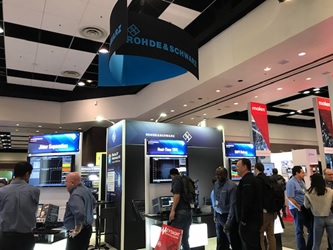 Rohde & Schwarz has developed a novel and powerful method for analyzing the individual components of jitter, providing electronic circuit designers with previously unavailable in-depth knowledge invaluable for debugging high-speed signals. As data rates increase and voltage swings decrease, the jitter in digital interfaces becomes a significant percentage of the signaling interval, and potential source of failures. Increasingly, engineers require tools that accurately characterize the signal jitter including the break-down into its individual components.
Rohde & Schwarz has developed a novel and powerful method for analyzing the individual components of jitter, providing electronic circuit designers with previously unavailable in-depth knowledge invaluable for debugging high-speed signals. As data rates increase and voltage swings decrease, the jitter in digital interfaces becomes a significant percentage of the signaling interval, and potential source of failures. Increasingly, engineers require tools that accurately characterize the signal jitter including the break-down into its individual components.
The new R&S RTO-/ RTP-K133 advanced jitter analysis option introduces an analytic approach to separating the individual components of jitter such as random jitter, and deterministic jitter components, such as data dependent and periodic jitter. This approach is based on a parametric signal model that fully characterizes the behavior of the transmission link under test.
A core benefit of this Rohde & Schwarz method is that the jitter model includes the complete waveform characteristic of the signal under test, in contrast to conventional methods that reduce the data to a set of Time Interval Error measurements. The result is consistent measurement data even for relatively short signal sequences, plus previously unavailable information such as the step response, or a distinction between vertical and horizontal periodic jitter.
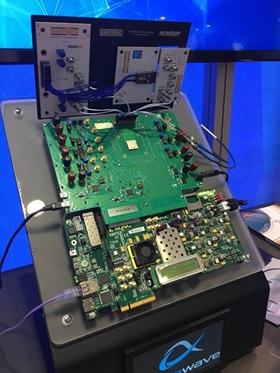 Samtec featured numerous demonstrations in its DesignCon booth. One notable one is the 112 Gbps PAM4 front-panel to mid-board flyover technology. This demo uses the NovaRay cable assembly and was designed for improved density and improved signal integrity performance. The cable can span 22 inches and allows connection from the chip to the front or back panel. In Figure 5 it is a front panel configuration. Another demonstration showed the Samtec Direct Connect technology, which supports optical and copper connectivity in the same connector. The connectors support high-speed, high-density applications such as data center, military, medical, telecom, or high-end computing applications.
Samtec featured numerous demonstrations in its DesignCon booth. One notable one is the 112 Gbps PAM4 front-panel to mid-board flyover technology. This demo uses the NovaRay cable assembly and was designed for improved density and improved signal integrity performance. The cable can span 22 inches and allows connection from the chip to the front or back panel. In Figure 5 it is a front panel configuration. Another demonstration showed the Samtec Direct Connect technology, which supports optical and copper connectivity in the same connector. The connectors support high-speed, high-density applications such as data center, military, medical, telecom, or high-end computing applications.
The Sierra Circuits team was ready in its booth to discuss how they can assist engineers with their designs. Specializing in PCB prototyping, Sierra Circuits supports rigid, flex, HDI, micro designs across aerospace, military, automotive, and medical applications. Their services range from self-service automated PCB fabrication to full support on advanced PCBs including stackup support, claiming they “will do the technology others won’t even try.”
Southwest Microwave released the industry’s first board (PCB) mounted 1.0 mm (W) Vertical Launch Connector. For microstrip or grounded coplanar waveguide (GCPW) designs, Southwest Microwave vertical launch connectors provide optimal signal integrity, are reusable and can be installed without soldering. The new 1.0 mm Vertical Launch Connector delivers low insertion loss and a VSWR of 1.35:1 max across 70 to 105 GHz and a VSWR of 1.6:1 max across the complete 110 GHz bandwidth. Data represents two 1.0 mm connectors mounted on test-board. Southwest Microwave also offers 1.85 mm (V) DC to 67 GHz (VSWR 1.25:1 max) and 2.92 mm (K) DC to 40 GHz (VSWR 1.15:1 max) Board-Mounted Vertical Launch Connectors. These connectors feature a common two-hole flange mounting footprint. The flange mounting holes are tapped for screws to be inserted from the bottom of the PCB. Connectors can be supplied with or without screws to accommodate for various PCB thicknesses.
In their booth, Nathan Tracy, TE Connectivity technologist and industry standards manager, stressed that they had the connector solutions to enable 100Gb/s in standard form factors. One in-booth demo (Figure) included an 800 Gb/s cable assembly demo with the octal small form-factor pluggable (OSFP) connector. Another demo included an inside the box 100Gb/s STRADA Whisper high-speed backplane connector. TE Connectivity also showcased its unique thermal bridge management products, which are basically a compressible heat sink, that are particularly well suited for use with optical transceivers.
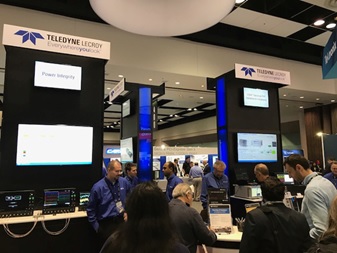 Teledyne LeCroy announced USB4 testing with the announcement of QualiPHY USB4 Electrical Transmitter (Tx) and Receiver (Rx) Compliance Test Software (QPHY-USB4-TX-RX) for its LabMaster 10 Zi-A and WaveMaster/SDA 8 Zi-B oscilloscopes used in conjunction with Anritsu’s Signal Quality Analyzer-R (SQA-R) MP1900A BERT. This announcement follows Teledyne LeCroy’s shipment of the first (and only) USB4 Protocol Analyzer in September of 2019.
Teledyne LeCroy announced USB4 testing with the announcement of QualiPHY USB4 Electrical Transmitter (Tx) and Receiver (Rx) Compliance Test Software (QPHY-USB4-TX-RX) for its LabMaster 10 Zi-A and WaveMaster/SDA 8 Zi-B oscilloscopes used in conjunction with Anritsu’s Signal Quality Analyzer-R (SQA-R) MP1900A BERT. This announcement follows Teledyne LeCroy’s shipment of the first (and only) USB4 Protocol Analyzer in September of 2019.
The combination of Teledyne LeCroy’s QPHY-USB4-TX-RX software and oscilloscopes with an Anritsu SQA-R MP1900A BERT provides USB4 electrical validation and test engineers an integrated electrical test solution for automated compliance testing, ensuring faster time-to-market. Key features of Teledyne LeCroy’s USB4 electrical test solution include:
- Automated Tx and Rx electrical tests outlined in the USB4 Router Assembly, USB4 Captive Device and Thunderbolt™ 3 Electrical Compliance Test Specifications – the first and only solution that provides this capability.
- Multi-lane analysis capability, which performs acquisition, analysis and compliance tests on both Tx lanes simultaneously, greatly reducing compliance test time.
Teledyne LeCroy announced the availability of an open-source software tool, SignalIntegrity, offering free solutions to signal integrity problems for design and test engineers. In order to avoid signal integrity issues in today's world of gigabit-per-second transfer rates, engineers must have superior tools for the necessary combination of simulation, modeling and measurement. The goal of this software is to provide free tools for solving real-time signal integrity problems. More than 1,500 users have downloaded the Python-based software since it has been made available.
They also announced the further development of its Teledyne Test Tools (T3)-branded portfolio of test equipment with the launch of the T3VNA1500 Vector Network Analyzer. This product launch enhances the existing T3 test equipment portfolio, adding to the affordable selection of test equipment that engineers, developers and schools can use to assemble a well-equipped test bench efficiently, reliably and within budget.

